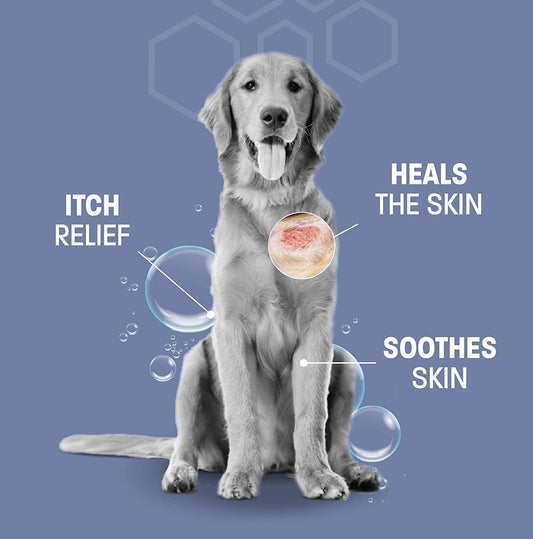Prevention is always better than cure, especially when it comes to UTIs in dogs. Pet Health Pros understands this well, offering a urinary tract supplement that serves as a preventive measure, keeping your dog's urinary health in check.
Your furry friend's health and well-being is a top priority, and one common issue that many dog owners face is urinary tract infections (UTIs). These infections can cause discomfort, pain, and even serious health complications for your beloved pet. If you're worried about preventing and treating canine UTIs, this article is a must-read for you.
What Are UTIs in Dogs?
Urinary Tract Infections (UTIs) in dogs are bacterial infections that affect the urinary system, including the bladder, urethra, and kidneys. These infections can be caused by various factors such as bacterial overgrowth, urinary stones, or underlying health conditions.
Common symptoms of UTIs in dogs include:
- frequent urination
- blood in the urine
- difficulty urinating
To prevent UTIs, it is important to:
- ensure that your dog has access to clean and fresh water
- maintain good hygiene
- feed them a balanced diet
Regular veterinary check-ups and prompt treatment of any underlying health issues are also crucial for preventing UTIs in dogs.
What Causes UTIs in Dogs?
Urinary tract infections (UTIs) are a common and often painful health issue for dogs. But what exactly causes these infections in our furry companions? In this section, we will take a closer look at the three main culprits behind canine UTIs: bacterial infections, urinary stones, and anatomical abnormalities. By understanding the root causes of UTIs, we can better equip ourselves to prevent and treat this uncomfortable condition in our beloved pets.
1. Bacterial Infections
Bacterial infections are the leading cause of urinary tract infections (UTIs) in dogs. To effectively manage and treat UTIs caused by bacteria, here are some steps to follow:
- Consult a veterinarian for a proper diagnosis and to determine the specific bacteria involved.
- Administer the prescribed antibiotics as directed, ensuring the full course is completed.
- Encourage proper hydration to promote urine flow and flush out bacteria.
- Consider incorporating cranberry supplements or natural remedies known to support urinary health.
By following these steps, you can help prevent and treat bacterial UTIs in dogs, promoting their overall well-being and comfort.
2. Urinary Stones
Urinary stones in dogs can cause discomfort and lead to urinary tract infections. To prevent and manage this condition, follow these steps:
- Ensure proper hydration by providing fresh water at all times.
- Feed a balanced diet that promotes urinary health, such as a prescription diet for stone prevention.
- Encourage regular urination breaks to prevent urine stagnation and stone formation.
- Monitor urine pH levels and adjust the diet accordingly to prevent crystal formation.
- Practice good hygiene by regularly cleaning your dog's genital area.
Pro-tip: If your dog is prone to urinary stones, consider adding a natural urinary acidifier, like cranberry extract, to their diet for additional support.
3. Anatomical Abnormalities
Anatomical abnormalities in dogs can contribute to the development of urinary tract infections (UTIs). These abnormalities may include structural issues in the urinary system, such as narrow urethras or malformations. When addressing anatomical abnormalities, several steps can be taken:
- Veterinary examination: A thorough examination by a veterinarian can help identify any structural abnormalities in the dog's urinary system.
- Diagnostics: Diagnostic tests like ultrasounds or X-rays may be conducted to further assess the extent of the anatomical abnormality.
- Treatment options: Depending on the severity of the anatomical abnormality, treatment options may range from medication to surgical intervention.
What Are the Symptoms of UTIs in Dogs?
Canine UTIs can be a common and uncomfortable health issue for our furry friends. As pet owners, it's essential to be aware of the symptoms of UTIs in dogs in order to seek prompt treatment and alleviate their discomfort. In this section, we will discuss the tell-tale signs to watch out for, including frequent and painful urination, as well as the presence of blood in the urine. By understanding these symptoms, we can better care for our canine companions and help them fight against UTIs.
1. Frequent Urination
Frequent urination in dogs can be a sign of a urinary tract infection (UTI). If you notice your dog urinating more often than usual, it is important to take the following steps:
- Monitor their water intake to ensure they are properly hydrated.
- Take them outside for regular bathroom breaks to prevent urine from building up in the bladder.
- Keep their living space clean and hygienic to reduce the risk of bacterial infections.
In ancient times, dogs were highly valued for their ability to alert humans to danger and protect their homes. They were often trained to be watchful and defensive, which led to frequent urination as a way to mark their territory and deter potential threats.
2. Painful Urination
Painful urination is one of the symptoms of urinary tract infections (UTIs) in dogs. It is crucial to address this issue promptly to provide relief and prevent further complications. Here are some steps to help alleviate painful urination in dogs:
- Consult a veterinarian to determine the underlying cause of the UTI.
- Follow the prescribed treatment plan, which may include antibiotics to eliminate the infection and reduce painful urination.
- Ensure that your dog has access to plenty of fresh water to promote hydration and flush out any bacteria.
- Monitor your dog's urination habits for any changes or difficulties.
- Consider providing a clean and comfortable area for your dog to urinate, such as using pee pads or a specially designed litter box.
- Practice good hygiene, including regularly cleaning the genital area to prevent bacterial growth and potential reinfection.
By following these steps, you can help alleviate your dog's painful urination and promote their overall urinary tract health.
3. Blood in Urine
Seeing blood in your dog's urine may be alarming, but it is a common symptom of urinary tract infections (UTIs) in dogs. If you notice blood in your dog's urine, it's important to take the following steps:
- Monitor the frequency and amount of blood in the urine.
- Contact your veterinarian and provide them with detailed information about your dog's symptoms.
- Follow your vet's instructions for collecting a urine sample for analysis.
- Bring the urine sample to your vet for examination.
- Based on the results, your vet will recommend the appropriate treatment for your dog's UTI.
- Administer any prescribed medications or follow any dietary recommendations provided by your vet.
- Monitor your dog's progress and follow up with your vet as needed.
How Are UTIs Diagnosed in Dogs?
To diagnose UTIs in dogs, veterinarians follow a series of steps:
- Physical Examination: The vet will examine the dog for any signs of discomfort or pain.
- Urinalysis: A urine sample is collected and analyzed to check for bacteria, blood, or crystals.
- Bacterial Culture: If bacteria are found in the urine, a culture is done to identify the specific bacteria and determine the appropriate antibiotics.
- Imaging: In some cases, imaging tests such as X-rays or ultrasounds may be performed to check for any underlying issues.
Pro-tip: If you notice any changes in your dog's urination habits or suspect a UTI, it is important to promptly seek veterinary care to ensure proper diagnosis and treatment.
What Is the Treatment for UTIs in Dogs?
When our furry companions are suffering from UTIs, it’s important to seek treatment as soon as possible. But what exactly does treatment for UTIs in dogs entail? In this section, we’ll explore the various options available for treating canine UTIs. From traditional antibiotics to dietary changes and even surgery, we’ll discuss the different approaches and their effectiveness in combating this common health issue in dogs.
1. Antibiotics
Antibiotics are a common treatment for UTIs in dogs. Here are the steps involved in using antibiotics to treat a UTI in dogs:
- Consult a veterinarian to diagnose the UTI and determine the appropriate antibiotic.
- Administer the prescribed antibiotics to the dog as per the veterinarian's instructions.
- Ensure the dog completes the full course of antibiotics, even if symptoms improve.
- Monitor the dog's response to the antibiotics and report any adverse effects to the veterinarian.
- Follow up with the veterinarian for any necessary tests or check-ups to ensure the UTI is fully resolved.
In the early twentieth century, Alexander Fleming discovered the first antibiotic, penicillin, which revolutionized the treatment of bacterial infections and paved the way for the development of numerous antibiotics that are still used today.
2. Dietary Changes
Making dietary changes is an important aspect of treating UTIs in dogs. Here are some steps to consider:
- Switch to a high-quality, balanced dog food that supports urinary health.
- Ensure that the dog is getting enough water to stay properly hydrated.
- Incorporate natural diuretics into the dog's diet, such as cranberry or parsley, to help flush out bacteria.
- Avoid feeding the dog foods that are known to irritate the urinary tract, such as spicy or salty foods.
- Consider adding supplements like probiotics or cranberry extract to support urinary health.
By making these 2. dietary changes, you can help alleviate the symptoms of UTIs in dogs and reduce the risk of future infections.
3. Surgery
Surgery is a potential treatment option for dogs with severe or recurrent urinary tract infections (UTIs). Here are the steps involved in the surgical treatment of UTIs in dogs:
- Evaluation: The veterinarian will assess the dog's condition, including the severity of the UTI and any underlying anatomical abnormalities.
- Preparation: Prior to surgery, the dog may need to undergo diagnostic tests, such as imaging, to identify any specific issues.
- Surgical Procedure: The surgeon will perform the necessary procedure, such as removing obstructions or correcting anatomical abnormalities.
- Postoperative Care: The dog will receive post-surgical care, including pain management and antibiotics, to prevent infection.
It is essential to follow the veterinarian's instructions for postoperative care to ensure the best outcome for the dog. Surgery should be considered as a last resort after exhausting other treatment options. Remember to consult with a veterinarian for personalized advice.
How Can UTIs in Dogs Be Prevented?
As pet owners, we want nothing but the best for our furry companions. One common health issue that dogs can face is a urinary tract infection (UTI). However, there are steps we can take to prevent our dogs from experiencing this painful and uncomfortable condition. In this section, we will discuss the importance of proper hydration, regular urination breaks, and good hygiene practices in keeping our dogs UTI-free. By implementing these measures, we can help our dogs live a happy and healthy life.
1. Proper Hydration
Proper hydration is essential for preventing UTIs in dogs. To ensure your furry friend stays well-hydrated, follow these steps:
- Always provide fresh and clean water, replacing it regularly.
- Consider using a water fountain or adding ice cubes to encourage your dog to drink more.
- Monitor your dog's water intake and make sure they are drinking enough each day.
- Incorporate water-rich foods, such as canned dog food or broth, into their diet.
- Offer moisture-rich treats like watermelon or cucumber.
- Keep water bowls easily accessible throughout the house.
2. Regular Urination Breaks
Regular urination breaks are crucial for preventing urinary tract infections (UTIs) in dogs. Here are some steps to incorporate into your dog's routine:
- Establish a schedule: Take your dog out for regular urination breaks throughout the day.
- Observe behavior: Watch for signs like restlessness, pacing, or sniffing to indicate your dog needs to go out.
- Prompt bathroom breaks: Take your dog outside immediately after waking up, after meals, and before bedtime.
- Provide access: Make sure your dog has easy access to a designated outdoor bathroom area.
- Supervise: Monitor your dog during bathroom breaks to ensure they fully empty their bladder.
3. Good Hygiene Practices
Good hygiene practices are essential for preventing urinary tract infections (UTIs) in dogs. Follow these steps to ensure your dog stays healthy:
- Regular bathing: Keep your dog clean by bathing them regularly with dog-friendly shampoos.
- Genital area cleaning: Pay special attention to the genital area and gently clean it with warm water and a mild cleanser.
- Frequent bathroom breaks: Take your dog out for regular bathroom breaks to ensure their bladder is emptied regularly.
- Proper grooming: Trim the hair around your dog's genital area to prevent bacteria from accumulating.
- Avoidance of toxic substances: Keep your dog away from chemicals, such as cleaning products and pesticides, that can irritate their urinary tract.
- Adequate hydration: Make sure your dog has access to fresh water at all times to promote proper hydration and flushing of the urinary system.
- Regular veterinary check-ups: Schedule regular check-ups with your vet to catch any potential urinary issues early on.
Proactively safeguard your dog against urinary tract infections with Pet Health Pros. Our supplement is more than just a treatment; it's a preventive measure, ensuring long-term urinary health for your dog.
Frequently Asked Questions
What are canine UTIs?
Canine UTIs, or urinary tract infections, are bacterial infections that occur in a dog's urinary tract, including the bladder, urethra, and kidneys.
What are the symptoms of canine UTIs?
The symptoms of canine UTIs may include frequent urination, straining to urinate, blood in the urine, and accidents in the house. Some dogs may also show signs of pain or discomfort when urinating.
How are canine UTIs diagnosed?
Canine UTIs are typically diagnosed through a combination of a physical examination, urinalysis, and urine culture. Your veterinarian may also recommend blood tests and imaging studies to further evaluate your dog's condition.
What causes canine UTIs?
Canine UTIs can be caused by a variety of factors, including bacteria entering the urinary tract through the urethra, underlying health conditions, and anatomical abnormalities. Female dogs are also more prone to UTIs due to their shorter urethras.
How can I prevent my dog from getting UTIs?
Some ways to prevent canine UTIs include providing plenty of fresh water for your dog to drink, promoting regular urination, and keeping your dog's genital area clean. It is also important to address any underlying health conditions that may increase your dog's risk for UTIs.
What are some treatment options for canine UTIs?
Treatment for canine UTIs typically involves a course of antibiotics prescribed by your veterinarian. Additionally, your dog may also need to increase their water intake and receive supportive care to help alleviate any discomfort or pain. In severe cases, surgery may be necessary to correct any anatomical abnormalities that are contributing to the UTI.








